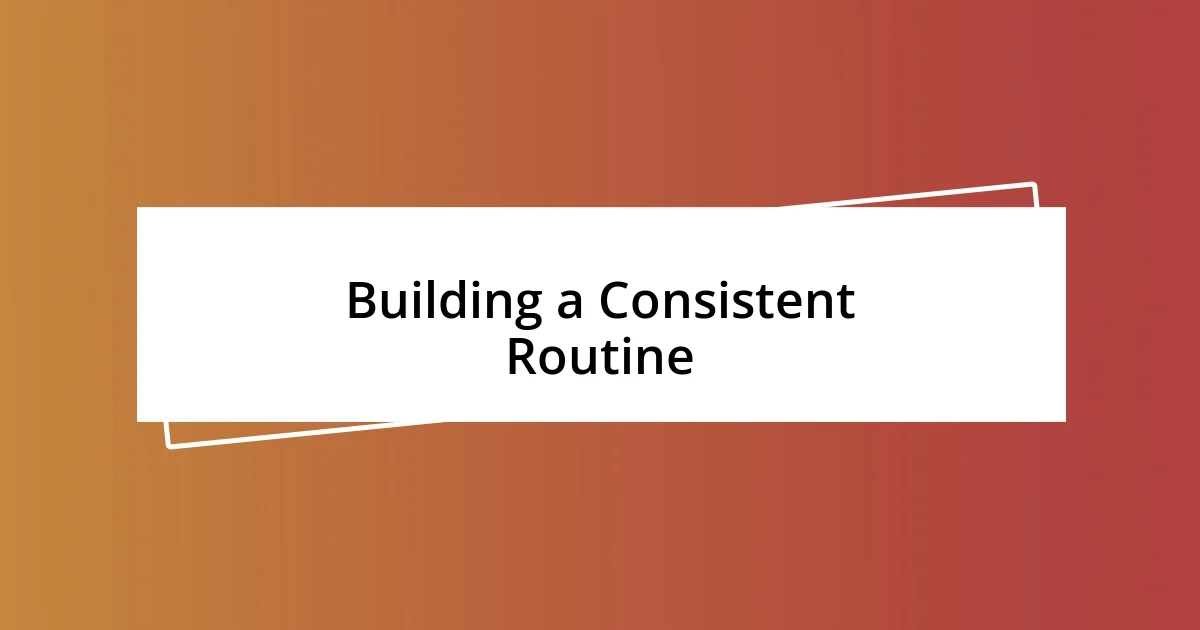Key takeaways:
- Effective time management involves prioritizing tasks, utilizing techniques like time blocking, and learning to say no to non-essential commitments to reclaim focus.
- Identifying personal productivity peaks through self-tracking can enhance efficiency, enabling people to tackle demanding tasks during their most energetic hours.
- Setting clear, SMART goals and using technology for task management promotes accountability and helps streamline productivity, allowing for consistent routines and regular evaluations of progress.

Understanding Time Management Basics
Time management is all about making choices. I remember when I used to feel overwhelmed with deadlines; it was exhausting. Reflecting on that experience now, I realize how vital it is to prioritize tasks. Ask yourself: what truly matters today? Knowing what deserves your attention can be eye-opening.
Understanding the basics also means recognizing the concept of time blocking. I stumbled upon this technique when I found myself easily distracted; by scheduling specific blocks of time for different activities, I gained more control over my day. Do you ever find that certain hours are more productive than others? Identifying those peak times has been a game changer for me.
We often underestimate the power of saying no. Early in my career, I too found it hard to turn down requests, leading to burnout. It struck me that every time I said yes to something unimportant, I was inadvertently saying no to my priorities. So, what about you? How can reclaiming your time by setting boundaries transform your productivity?

Identifying Personal Productivity Peaks
Recognizing when I am at my most productive has been a revelation. Initially, I just went through my day without paying attention to my energy levels. It wasn’t until I started tracking my work patterns that I noticed consistent peaks in my focus and creativity, usually mid-morning or late afternoon. This insight shifted the way I approach my tasks, enabling me to tackle my most challenging projects during those high-energy windows.
To help identify your productivity peaks, consider the following:
- Keep a Log: For a week, jot down when you feel most alert and engaged during the day. This can highlight trends in your productivity.
- Observe Energy Patterns: Notice how your energy fluctuates post-meals, after breaks, or with different work types. Do you feel a slump in the early afternoon?
- Experiment with Variations: Try shifting your most demanding tasks to different times and see what works best. How do your results compare?
- Listen to Your Body: Pay attention to signals like yawning or distractions. They often indicate a drop in productivity.
- Reflect Regularly: At the end of each week, look over your notes. Reflection can illuminate patterns you might have missed during the rush of daily life.
By embracing these strategies, I now structure my work schedule to align with my natural productivity cycles, and it’s made a remarkable difference in how much I accomplish while feeling less drained.

Setting Clear and Achievable Goals
Setting clear and achievable goals is a cornerstone of effective time management. I vividly remember the frustration of setting vague goals that led to feelings of futility. Once, I aimed to “get more work done” without specifics, and it left me wandering through my day with no direction. Now, I break my goals into SMART criteria—Specific, Measurable, Achievable, Relevant, and Time-bound. This clarity not only gives me a roadmap but also boosts my motivation when I check off completed tasks.
When I started implementing this approach, I noticed a significant shift in my mindset. Instead of feeling overwhelmed, I began to feel a sense of control. For example, last year, I set a goal to enhance my skills in public speaking. Instead of just deciding to “practice more,” I outlined a plan: attend a workshop, practice weekly in front of friends, and schedule two speaking opportunities. This structured path made the entire process not only manageable but genuinely enjoyable.
Emotional investment in my goals makes a notable difference as well. I often remind myself to connect my objectives with personal values or desires, enhancing their significance. For instance, when I aimed to read more books, it wasn’t solely about the number—it was about personal growth and reflecting on ideas that intrigue me. What connects you to your goals? Creating a personal tie can create a deeper commitment, turning tasks into fulfilling challenges.
| Goal Setting Approach | Description |
|---|---|
| Vague Goals | Unclear and open-ended, leading to confusion and lack of direction. |
| SMART Goals | Specific, Measurable, Achievable, Relevant, and Time-bound goals provide clarity and motivate action. |
| Emotional Connection | Linking goals to personal values strengthens commitment and enjoyment in the process. |

Using Prioritization Techniques Effectively
Using Prioritization Techniques Effectively
When I first dove into prioritization techniques, I felt overwhelmed by the sheer number of options available. However, I found success using a simple method called the Eisenhower Matrix, which divides tasks into four categories: urgent, important, not urgent, and not important. This visual breakdown helped me make quick decisions about what to tackle first, especially during hectic periods. Have you ever wondered why some tasks seem to consume your entire day but yield little satisfaction? That was my experience until I prioritized effectively.
As I applied this technique, I noticed my perspective on daily tasks transformed. For instance, when managing a project deadline, I learned to distinguish between what needed immediate attention and what could wait. Once, I had a last-minute report due, but I mistakenly focused on perfecting a less impactful presentation. Realizing the mistake mid-process offered a wake-up call; now, I consciously identify which tasks propel me towards my goals and which merely fill time.
Moreover, I’ve come to appreciate the value of the “two-minute rule,” where if a task can be completed in two minutes or less, I do it right away. This technique clears small tasks quickly, allowing me to maintain momentum throughout my day. Why let tiny actions pile up when a simple decision can keep the workflow smooth? Adopting this principle has not only enhanced my productivity but also left me feeling accomplished, as I witness the immediate effects of small victories.

Leveraging Technology for Better Management
Leveraging technology has drastically transformed my time management strategy, providing me with tools that streamline my tasks. For example, I use a task management app to track my daily responsibilities. This app allows me to set reminders, categorize tasks by priority, and even share progress with my team. Have you ever wondered how a simple notification can change the way you approach your day? I have found that these nudges keep me accountable and help prevent procrastination, which can creep in when I’m working on complex projects.
I realized just how impactful automating mundane tasks can be. For instance, I recently integrated a calendar synchronization feature with my scheduling tools. It automatically updates my commitments and sends me alerts, so I never miss a meeting. The relief I felt when I discovered I could cut down on double bookings was immense! Have you ever been in a situation where a simple tech solution resolves a recurring headache? That’s the beauty of modern tools—they serve as silent partners, allowing me the mental space to focus on creativity and strategizing rather than logistics.
Additionally, I make great use of time-tracking software to understand how my hours are spent. By analyzing my weekly reports, I discovered that my afternoons were less productive due to frequent distractions. This insight prompted me to adjust my schedule, allocating critical tasks to my most vibrant morning hours. Isn’t it powerful to gain clarity on how you genuinely spend your time? In this way, technology acts not just as a facilitator but also as an informed coach, guiding me towards optimizing my time management with intelligence.

Building a Consistent Routine
Building a consistent routine has been a game-changer for me. I began by establishing non-negotiable daily rituals, such as waking up at the same time each day and dedicating the first hour to planning my tasks. Initially, I found it challenging to stick to these habits, but I soon realized that this time invested in setting up my day laid a strong foundation for productivity. Have you ever noticed how much calmer your mind feels when you know exactly what your day will look like?
One memorable instance was when I started incorporating a short morning meditation into my routine. At first, just a few minutes of stillness felt unnatural, almost like I was wasting time. However, as I got used to it, I discovered that this practice helped clear my mind and sharpen my focus. Have you ever considered how a brief moment of mindfulness can shift your entire day’s trajectory? I learned that a little space for reflection provides clarity, making it easier to tackle my responsibilities with renewed energy.
Evenings are another crucial part of my routine. I’ve made it a habit to spend the last 15 minutes of my day reviewing what I’ve accomplished. This reflection not only helps me celebrate small victories but also sets the stage for the next day. I often find myself jotting down goals for tomorrow, which gives me a head start. Is there anything more motivating than waking up to a clear purpose? I truly believe that the habit of looking back can empower the forward journey, making each day feel intentional and productive.

Evaluating and Adjusting Your Approach
Evaluating and adjusting my approach to time management has become an essential part of my process. I remember one particular project where I overscheduled myself, thinking more tasks meant greater productivity. It wasn’t until I sat down to review my progress that I realized I was barely making a dent. Have you ever felt overwhelmed despite your best efforts? That moment of reflection allowed me to recalibrate my task list and prioritize only what truly mattered.
After identifying the need for change, I implemented regular weekly reviews as a part of my time management routine. Each Sunday evening, I assess what worked and what didn’t during the previous week. This practice was eye-opening! I discovered fascinating patterns about my productivity—like how certain tasks drained my energy while others invigorated me. This revelation led me to adjust not only my schedule but also the type of tasks I took on. Isn’t it empowering to make choices that align with your strengths instead of battling through tasks that sap your energy?
In the spirit of continuous improvement, I’ve learned the importance of being flexible. Just the other day, I found my planned workday didn’t fit my energy levels, which had been surprisingly low due to a sleepless night. Rather than push through, I allowed myself to adapt, moving less critical tasks to later and embracing a slower pace. How often do we resist the urge to pivot? I think it’s vital to listen to those internal signals. Recognizing when to adjust isn’t a sign of weakness; it’s a powerful strategy for maintaining long-term productivity and well-being.












